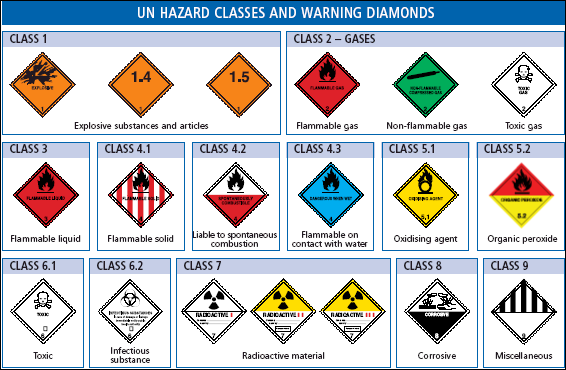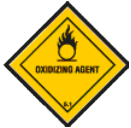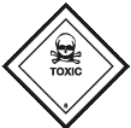
CLASS 1
EXPLOSIVES
Should be stored away from the crew’s quarters and the ship’s boats and immediately under the hold’s hatches.
Substances included in this class:
Gunpowder, Fireworks, Smokebombs, Munitions, Dynamite etc.
 CLASS 2
CLASS 2
GASES
CLASS 2.1
FLAMMABLE GASES: Should be stored away from crew’s quarters and any source of heat.
Substances included in this class:
Acetylene, Ethane, Ethylene, Methane, Hydrogen, Lighter Gas etc.
 CLASS 2.2
CLASS 2.2
GASES
CLASS 2.1
TOXIC GASES: Should be stored away from any source of heat, the crew’s quarters and foodstuffs.
Substances included in this class:
Ammonia, Flor, Prussic Acid, Chloride, Carbon Monoxide etc.
 CLASS 2.3
CLASS 2.3
NON-FLAMMABLE COMPRESSED GASES: Store on or under the deck in a cool, well-ventilated place. Containers filled with this kind of gas will expand if heated and there is a high risk of an explosion.
Substances included in this class:
Argon, Helium, Carbon Dioxide, Coal Gas, Oxygen etc.
 CLASS 3
CLASS 3
FLAMMABLE LIQUID
Inflammable liquids are divided into three groups according to the temperature at which, in a vapour state, they explode when heated.
CLASS 3.1
PETROL: Combustion at less than 18°C. Should always be stored above the deck.
CLASS 3.2
FUEL OIL: Combustion at between 18°C and 23°C. Should be stored above or below the deck
CLASS 3.3
FUEL OIL: Combustion at between 23°C and 61°C. Should be stored below the deck.
 CLASS 4
CLASS 4
GASES
CLASS 4.1
FLAMMABLE SOLID : Should be stored on top or below the deck. Should be kept away from living quarters.
Substances included in this class :
Aluminum Powder, Celluloid, Naphthalene, Red Phosphorus, Films, Naphtha Oil, Dry Fiber etc.
 CLASS 4.2
CLASS 4.2
SPONTENOUSLY COMBUSTIBLE : Should be stored in well ventilated areas and air should be able to circulate between the stored materials.
Substances included in this class:
Copra, Fish Powder, Hay, Charcoal etc.
CLASS 4.3
DANGEROUS WHEN WET: Solids which are inflammable when wet or when in contact with water. Should be stored in well ventilated, dry areas and always away from any contact with water
Substances included in this class:
Alkaline Alloys, Barium, Calcium Carbide, Ferro Silicon, Natrium, Magnesium etc.
 CLASS 5
CLASS 5
OXIDIZİNG SUBSTANCES
CLASS 5.1
OXIDIZING AGENT: The substances in this category can create an inflammable environment when brought into contact with oxygen. For this reason they should not be stored next to combustible materials.
Substances included in this class:
Nitrate, Artificial Fertilizers, Ammonium Sulphate, Barium Chlorate etc.
 CLASS 5.2
CLASS 5.2
ORGANIC PEROXIDE: The substances in this class can be inflammable or explosive. They should be stored above deck, covered and in a dry, cool areas.
Substances included in this class:
All peroxides
 CLASS 6
CLASS 6
TOXIC
CLASS 6.1
TOXIC SUBSTANCES: Toxic substances are those which can enter the human body through the mouth and cause death. For this reasons they should be stored away from foodstuffs, drinks, living quarters and materials which increase humidity, such as tobacco.
Substances included in this class:
Arsenic, Aniline, Barium Oxide, Phenol, Nicotine, Lead, Cyanide, Mercury Products etc.
 CLASS 6.2
CLASS 6.2
INFECTIOUS (BIOLOGICAL) SUBSTANCES : These substances contain microbes which can cause illness. They should be stored away from foodstuffs, drinks and living quarters. In case of danger the nearest health authority should be notified.
Substances included in this class:
Bones, Marrow, Condensed Meat Wastes, Animal Skins, Dehydrated Blood etc
CLASS 7
RADIOACTIVE MATERIALS
These materials should be transported in specially sealed containers. The seals must always be completely undamaged. They should preferably be stored above deck and away from living quarters, foodstuffs, unprocessed films, pharmaceuticals and chemical substances. They are divided into three groups according to their level of radioactivity.



 CLASS 8
CLASS 8
CORROSIVES
The substances in this class are solids or liquids possessing, in their original state, the common property of being able, more or less severely to damage living tissue. The escape of such a substance from its packaging may also cause damage to other cargo or the ship. Corrosive substances are apportioned among three categories (packaging groups) according to the degree of danger they present.
 CLASS 9
CLASS 9
MISCELLANEOUS DANGEROUS SUBSTANCES
Class 9 comprises:
1 – Substances and articles not covered by other classes which experience has shown, or may show, to be of such a dangerous character that the provisions of SOLAS should apply. These include substances that are transported or offered for transport at temperatures equal to or exceeding 1000 C and in a liquid state, and solids that are transported at temperatures equal or exceeding 2400 C;
2 – Harmful substances not subjects to the provisions of SOLAS, but to which the provisions Annex III of MARPOL apply. They are divided into two categories according to the degree of danger they present: medium danger (packing group II) and minor danger (packing group III).


